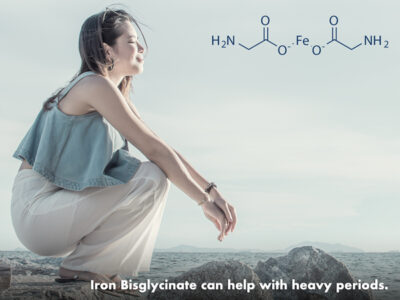For HEAVY PERIODS, a well-absorbed iron chelate like iron bisglycinate has a direct action to slow heavy flow, and is essential to replenish ferritin iron storage levels at a steady, healthy pace. Although it might seem obvious to replace iron after blood loss, it is less well-known that chronic iron deficiency can also cause menorrhagia, abnormally heavy menstrual bleeding. If there are low levels of ferritin – the body’s storage repository of iron – menstruation can be prolonged. Then a vicious cycle is created of heavier periods that worsen declining iron levels. Iron works to slow heavy period flow because it helps small capillaries to contract when necessary, and thus staunch and stop bleeding. And further, if iron deficiency anemia occurs, the body may then suffer low levels of platelets, which are needed for blood clotting, exacerbating menstrual blood loss.
 Iron is a mineral that is essential to maintain life: it is the crucial element required for red blood cell formation. Iron is found in hemoglobin, where it helps to transport oxygen from the lungs and to carry carbon dioxide waste away from tissues to be exhaled from the lungs. Iron also occurs in myoglobin in muscles as seen in red meat, and it has key roles for enzymes that enable energy production and DNA formation. Usually when old red blood cells die, the body retrieves their iron, and recycles it into the next generation of red cells. If this retrieval process fails, iron and ferritin stores drop. This happens faster if blood loss outstrips the amount of iron ingested.
Iron is a mineral that is essential to maintain life: it is the crucial element required for red blood cell formation. Iron is found in hemoglobin, where it helps to transport oxygen from the lungs and to carry carbon dioxide waste away from tissues to be exhaled from the lungs. Iron also occurs in myoglobin in muscles as seen in red meat, and it has key roles for enzymes that enable energy production and DNA formation. Usually when old red blood cells die, the body retrieves their iron, and recycles it into the next generation of red cells. If this retrieval process fails, iron and ferritin stores drop. This happens faster if blood loss outstrips the amount of iron ingested.
About 30% of menstruating females are anemic due to iron loss, and iron deficiency anemia (IDA) is the most common nutritional deficiency worldwide, affecting approximately 20 to 30% of the world’s population, predominantly children and menstruating women. According to the World Health Organization (WHO), women of reproductive age are at increased risk of anemia because of chronic iron depletion during the menstrual cycle and it is estimated that worldwide there are 469 million anemic women of reproductive age. The WHO published their recommended guidelines for iron supplementation in 2011 based on a systematic review including 21 randomized controlled trials involving 10,258 women from fifteen countries in Latin America, Asia, Africa, and Europe. Women taking intermittent iron supplements had higher hemoglobin and ferritin concentrations, and they were less likely to develop anemia than those who did not receive the supplements or were given a placebo.1,2
Menorrhagia, excessively heavy periods, affects ten million women in the U.S. alone. It can have many causes including: insufficient progesterone in the second luteal half of the menstrual cycle, estrogen dominance, uterine polyps or fibroids, perimenopause, adenomyosis (displaced endometrial tissue), low or sluggish thyroid function, blood clotting abnormalities, and rarely, vitamin K deficiency.
Low levels of iron reduce the ability of the body to make red blood cells. Iron deficiency is accompanied by low levels of the iron-storage protein ferritin. Low iron levels can lead to poor oxygenation of tissues, which can result in fatigue, weakness, poor immune function, frequent colds or flu, hair loss, shortness of breath, tinnitus, and trouble concentrating. Taking an absorbable form of iron can rebuild ferritin iron stores, improve fatigue and boost immune resistance, as well as helping to decrease the excessive flow of heavy periods.
In our clinic, iron in a chelate form such as bisglycinate has several major advantages that we have seen over other formulations of iron. It is almost always non-constipating, and very rarely affects the frequency or texture of bowel movements, even for patients with a history of slow digestion or chronic constipation. Secondly, the iron is in a chelate form, attached to a derivative of the amino acid glycine, which is a protein building block, and so the body easily recognizes the combination. Iron chelates are especially well absorbed, far better than inorganic sulfate. We track patients’ iron needs by measuring blood levels of ferritin; if ferritin levels are low, the iron must be in a highly-absorbable form or months of supplement-taking would be ineffective.
Recommendation: Iron bisglycinate or chelate 25mg one to three times daily, with any meals, or as directed by your healthcare provider.
References
- World Health Organization. “Guideline: Intermittent iron and folic acid supplementation in menstruating women.” (2011).
- Fernandez-Gaxiola AC, De-Regil LM. Intermittent iron supplementation for reducing anaemia and its associated impairments in menstruating women. Cochrane Database Syst Rev 2011:CD009218.
- Taymor, Melvin L., Somers H. Sturgis, and Clement Yahia. “The etiological role of chronic iron deficiency in production of menorrhagia.” JAMA 187.5 (1964): 323-327.
- Agency for Healthcare Research and Quality (AHRQ). Primary Care Management of Abnormal Uterine Bleeding. Comparative Effectiveness Review No. 96. Rockville (MD): AHRQ, March 2013.
- National Institute for Health and Care Excellence (NICE). Heavy menstrual bleeding: assessment and management. January 2017. NICE Guidelines; Volume 44.
- Ramy Ibrahim, et al. Triad of iron deficiency anemia, severe thrombocytopenia and menorrhagia—a case report and literature review. Clinical medicine insights. 2012;5:23-27.
- Uberti, Francesca et al. Iron absorption from three commercially available supplements in gastrointestinal cell lines. Nutrients. 2017 Sep; 9(9): 1008.
- Vaucher, Paul et al. Effect of iron supplementation on fatigue in nonanemic menstruating women with low ferritin: a randomized controlled trial. CMAJ. 2012 Aug 7; 184(11): 1247-1254.